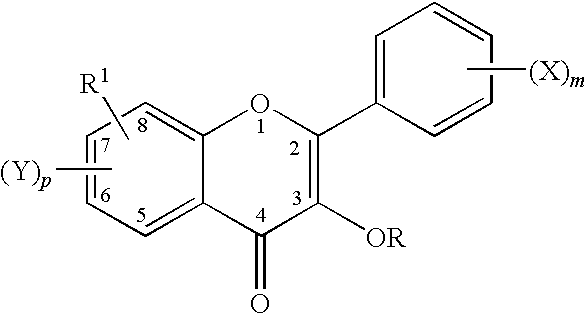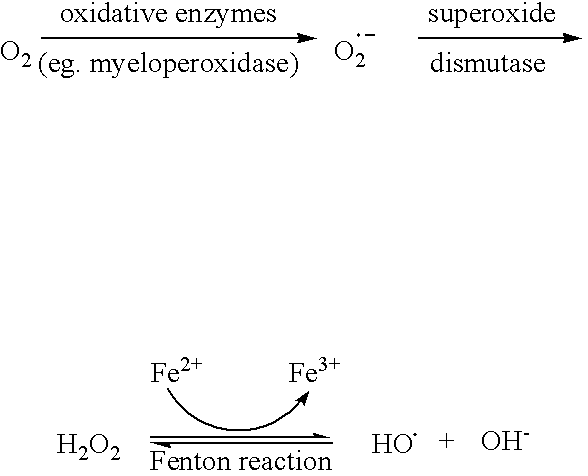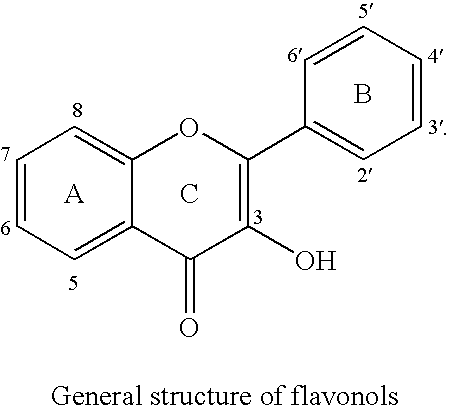Flavonols
a technology of flavonols and compounds, applied in the field of flavonol compounds with improved properties, can solve the problems of long-term disability in 1.10 million australians, heavy economic burden of cvd, and figure will continue to ris
- Summary
- Abstract
- Description
- Claims
- Application Information
AI Technical Summary
Benefits of technology
Problems solved by technology
Method used
Image
Examples
example 1
4-Acetamidoanisole
[0136]Acetic anhydride (16.0 mL, 169 mmol) was added dropwise over 1 h to a mixture of p-anisidine (20.0 g, 162 mmol) and dichloromethane (60 mL), with moderation by cooling in a water bath. The mixture was stirred at room temperature for 1 h, during which time a solid formed. Petroleum spirit (190 mL) was added, and the mixture was stirred for a further 1 h. The mixture was filtered and washed with petroleum spirit to afford 4-acetamidoanisole as a pale grey solid (25.8 g, 96%), m.p. 127-128° C. 1H NMR (399.7 MHz, CDCl3) δ 2.13, 3.78 (2 s, 2×3H, 2×CH3); 6.83 (app. d, 2H, J=8.8 Hz, BB′); 7.38 (app. d, 2H, J=8.8 Hz, AA′); 7.59 (br s, 1H, NH).
example 2
5-Acetamido-2-hydroxyacetophenone (4)
[0137]Aluminium chloride (56.0 g, 420 mmol) was added in four portions over 45 min to a mixture of 4-acetamidoanisole (20.0 g, 121 mmol) and acetyl chloride (25.8 mL, 363 mmol) in dichloromethane (190 mL). After addition of the first portion, the mixture became clear, and after addition of all four portions, a suspension formed again. The mixture was then heated at reflux for 4.5 h, after which it was cooled and poured into ice / water and vigorously stirred for 30 min. The resultant slurry was filtered and washed with water and the solid was dried to afford the acetophenone (4) as a light green powder (18.2 g, 78%), m.p 163-167° C. 1H NMR (399.7 MHz, CDCl3) δ 2.18 (s, 3H, CH3CON); 2.62 (s, 3H, CH3COAr); 6.93 (d, 1H, J3,4 9.0 Hz, H3); 7.34 (dd, 1H, J3,4 9.0, J4,6 2.6 Hz, H4); 8.17 (d, 1H, J4,6 2.6 Hz, H6); 12.10 (s, 1H, NH).
example 3
5′-Acetamido-2′-hydroxychalcone (5)
[0138]Aqueous NaOH (12 mL of 25.2 g / 100 mL) was added to a mixture of 5-acetamido-2-hydroxyacetophenone (4) (1.00 g, 5.18 mmol) and benzaldehyde (0.79 mL, 7.77 mmol) in ethanol (12 mL), and the mixture was stirred at room temperature for 6 h. The mixture was acidified with 30% aqueous acetic acid, with cooling on ice. The mixture was stirred for 1 h and filtered to afford the chalcone (5) as a brown solid (1.20 g, 82%), m.p. 162-165° C. 1H NMR (399.7 MHz, CDCl3) δ 2.21 (s, 3H, CH3); 6.98 (d, 1H, J3′, 4′ 8.8 Hz, H3′); 7.34 (dd, 1H, J3′, 4′ 8.8, J4′, 6′ 2.4 Hz, H4′); 7.41-7.44 (m, 3H, H3,4,5); 7.61-7.69 (m, 3H, H2,6,C═CH); 7.92 (d, 1H, Jtrans 15.6 Hz, CH═C); 8.41 (d, 1H, J4′,6′ , 2.4 Hz, H3′).
PUM
| Property | Measurement | Unit |
|---|---|---|
| temperature | aaaaa | aaaaa |
| temperature | aaaaa | aaaaa |
| temperature | aaaaa | aaaaa |
Abstract
Description
Claims
Application Information
 Login to View More
Login to View More - R&D
- Intellectual Property
- Life Sciences
- Materials
- Tech Scout
- Unparalleled Data Quality
- Higher Quality Content
- 60% Fewer Hallucinations
Browse by: Latest US Patents, China's latest patents, Technical Efficacy Thesaurus, Application Domain, Technology Topic, Popular Technical Reports.
© 2025 PatSnap. All rights reserved.Legal|Privacy policy|Modern Slavery Act Transparency Statement|Sitemap|About US| Contact US: help@patsnap.com



